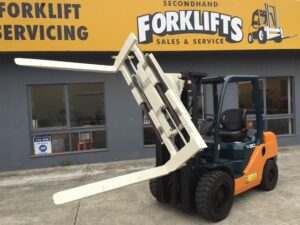 What is an attachment? Where would I use one?
What is an attachment? Where would I use one?
In the world of forklifts, attachments are often relegated to the sidelines, assumed to only be suitable for specialist applications. But if applied correctly to your task, an attachment can easily make your work quicker and safer.
So what is a forklift attachment?

There are also unpowered attachments. These are simpler, either being a ‘pick-up’ type where the forklift can pick up the attachment in a conventional manner or a bolt on type that is permanently attached to the forklift, usually replacing the tynes in the process. Examples include Carpet Poles (Long, thin poles extending from the front of the carriage to carry carpet and other rolled materials and jibs short crane extensions that hang from the tynes allowing heavy items such as engine blocks to be carried.)
Choices, choices, choices
Before purchasing a forklift, examine what you need it to do and decide if it could be done easier or more efficiently with an attachment. If you decide you don’t need one at all, make that clear to your salesman, as you don’t want to pay for something that you don’t need. Also remember that in many cases attachments are essentially fixed permanently in place, and often the weight and design of the attachment will compromise the general utility and weight capacity of the forklift, and in some cases such as bale grabs will prevent the forklift from lifting anything at all apart from the rolled goods that the bale grab was designed for. There are quick release fittings available which can make it easier to change the attachment to conventional tynes, but the weight of the attachment means you won’t want to do this every day.
Specific types of attachment
Sideshift
The most common attachment by far is the sideshift. Now almost standard equipment on new forklifts, the sideshift allows the carriage to move left and right independently of the forklift itself. If you have ever tried to pick up a pallet in a tight spot and been an inch off alignment, you know how valuable these can be. These are usually the cheapest of the powered attachments.
Fork Positioners
More common on larger capacity forklifts (where you would be hard pushed to move the tynes yourself), fork positioners are a step up from sideshift (the two are often supplied together), they allow the tynes to spread simaltaneously, thus altering the width of the tynes, enabling larger or smaller loads to be picked up without having to transfer to another pallet or manually move the tynes. Very useful, especially in wrecking or timber yards and the like. The disadvantages? Heavy (reduces carrying capacity) and expensive.
Rotators
Great for tipping loads into bins or flipping over items that are upside-down. Comes in 180 or 360 degree rotation.
Bale Clamps
This is getting a bit more specialised. If you know you need one of these, then you probably already have one. For picking up Bales and rolls of paper or other bulky products. Vital for some operations, a major downside is that they exclude use as a normal forklift.
Other Specialist Attachments
This list can go on forever. You can even get attachments custom made to your specifications (if your pockets are deep enough). A quick list includes:
- Integral Carriages
- Push/Pulls
- Carton Clamps
- Multiple Load Handlers
- Clamps
- Layer Pickers
- Specialty Products
- Construction Attachments
Retro-fitting
If you would like a quote on fitting an attachment to your existing forklift? We do it nearly every week, for sideshifts we even offer on site service. We are happy to answer any questions you may have, contact us today and we’ll talk through your needs and fit the attachment you need.
Classes

Cost
This is the big one. Because these are low volume, heavy weight precision items, they are usually very dear. We have received quotes from suppliers for up to $20,000 for a single new unit. So it’s worth considering whether you really need that particular attachment, and if it is available secondhand at all. However, not all attachments are expensive, things like new class 2 and 3 sideshifts, due to their popularity, have become commoditised. We can usually supply and fit a class 2 sideshift for $800 on a modern forklift. Give us a call to find out more information or for a detailed quote.
For more details and pictures, we recommend you check out Cascade, the worlds most well known attachment company. For non-powered attachments, a great range can be found at Drum Handling Equipment, they also supply cages, ramps and other engineered products.

 What is an attachment? Where would I use one?
What is an attachment? Where would I use one?